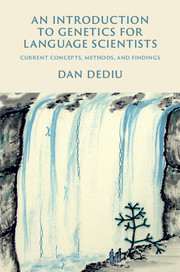Book contents
- Frontmatter
- Dedication
- Contents
- List of illustrations
- Acknowledgements
- 1 Introduction
- 2 Nature, nurture, and heritability
- 3 The molecular bases of genetics
- 4 Effects of genes on phenotype
- 5 Linkage disequilibrium and its role in finding genes
- 6 What do genes actually do?
- 7 The way forward: exome and genome sequencing
- 8 Population and evolutionary genetics
- 9 Interactions between genetic and cultural evolution
- 10 Conclusions, topics not covered, future directions
- Appendix The computer code
- References
- Index
- Glossary
3 - The molecular bases of genetics
Published online by Cambridge University Press: 05 April 2015
- Frontmatter
- Dedication
- Contents
- List of illustrations
- Acknowledgements
- 1 Introduction
- 2 Nature, nurture, and heritability
- 3 The molecular bases of genetics
- 4 Effects of genes on phenotype
- 5 Linkage disequilibrium and its role in finding genes
- 6 What do genes actually do?
- 7 The way forward: exome and genome sequencing
- 8 Population and evolutionary genetics
- 9 Interactions between genetic and cultural evolution
- 10 Conclusions, topics not covered, future directions
- Appendix The computer code
- References
- Index
- Glossary
Summary
After encountering the complexities of genetics at an abstract level, it is time to get our hands dirty and discover how the genetic information is actually stored, transmitted and expressed. We will encounter the structure of a typical animal cell, forming the appropriate context for understanding the DNA. We will see that far from being an abstract, mathematical message composed of the four letters A, T, C and G, the DNA molecule is a living, complex entity that not only stores genetic information across generations, but allows it to interact with the internal and external environment on extremely short time-scales. This chapter covers the processes of replication (ensuring the faithful transmission of genetic information), transcription and translation (expressing the genetic message) and we will survey the structure of the chromosomes (discovering recombination, a very important process for generating diversity) and that of genes.
We, as biological organisms, are composed of trillions of specialized cells, organized and coordinated through mechanisms of bewildering complexity and beauty, and any proper understanding of what we are must, at some point, face this level of organization. Far from a brutal reductionism or molecularism, we must understand how molecules interact and organize in increasingly complex structures and how these “levels” of organization continuously “talk” to each other and with the “environment” – including culture – because all these “higher” structures – language, art, culture in general – build upon, and form an organic whole with the molecules which compose us. It is emphatically not about explaining, say, the Great Vowel Shift in terms of quantum interactions between carbon, oxygen and nitrogen atoms, but about articulating the appropriate historical, phonological and phonetic explanations in their proper living human context, which imposes specific limitations and creates specific affordances. Ultimately, this will allow a proper understanding of the processes that made culture possible and that continue to shape and remodel it to the present day.
We will introduce here this maddeningly dynamic aspect of genetics as it has already forced massive reappraisals of what we thought we knew and what we were complacently taking as dogma, from the nature of “genetic information” and “innateness” to how evolution works, and how culture and language are shaped by, and shape in turn, our biology.
- Type
- Chapter
- Information
- An Introduction to Genetics for Language ScientistsCurrent Concepts, Methods, and Findings, pp. 44 - 71Publisher: Cambridge University PressPrint publication year: 2015



